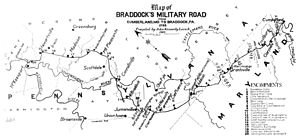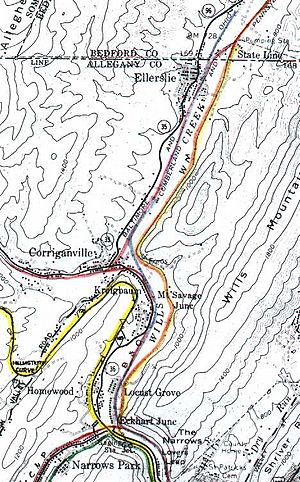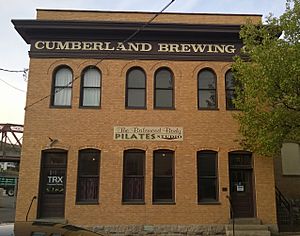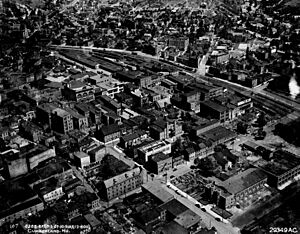History of Cumberland, Maryland facts for kids

Cumberland, Maryland is a city named after Prince William, the son of King George II. It was built where the old Fort Cumberland once stood. This fort was a starting point for British General Edward Braddock's attack on Fort Duquesne (now Pittsburgh) during the French and Indian War.
Cumberland was also an important place for Colonel George Washington during the French and Indian War. His first military headquarters was built here. Washington later returned as President in 1794 to check on troops gathered to stop the Whiskey Rebellion.
In the 1800s, Cumberland was a major hub for roads, railroads, and canals. It was once the second-largest city in Maryland, after Baltimore, earning it the nickname "The Queen City." The nearby hills provided coal, iron ore, and timber, which helped fuel the Industrial Revolution. The city also had many factories making glass, beer, fabrics, and tinplate. However, after World War II, its factories became less important, and its population dropped from nearly 40,000 in 1940 to less than 22,000 today.
Throughout its history, Cumberland has been a busy place. It started as a military fort and became the beginning of America's first highway. It was also the end point of a huge canal project and a gateway to the Ohio River Valley. It processed coal from rich mines and was a key link for successful railroads. Cumberland is located where mountains meet and where Wills Creek flows into the Potomac River. Its layout fits the hilly land around it. From its start as a British fort to its current role as western Maryland's second-largest city, Cumberland has always been known as "The Queen City."
Contents
Early History of Cumberland
Long before Europeans arrived, people lived in the Cumberland area. Evidence shows civilizations existed here even before the 1st century. Before 1730, a group of Native Americans lived where Wills Creek meets the Potomac River, which is now modern-day Cumberland. This village was called Caiuctucuc. It had wigwams built mostly along the Potomac riverfront. The natives called the Potomac River the Cohongaronto River and Wills Creek the Caiuctucuc Creek.
Colonial Times
Around 1750, the first European settlers changed the name of Caiuctucuc to Wills Creek. They named the settlement Wills Town after an Indian chief named "Will." He lived on the mountain north of the village. Most Native Americans moved west to the Ohio River Valley when Europeans arrived. But Chief Will was friendly and stayed with a few followers on his mountain. He supposedly died there after the American Revolutionary War. An old grave on Will's Knob is thought to be his. Chief Will sold his land along the creek to the settlers for very little.
When Europeans moved into western Maryland in the 1730s and 1740s, they met Native Americans living between the Potomac and Susquehanna rivers. This led to conflicts. In 1744, the Maryland government bought the land from the Native Americans. This allowed official settlement. Germans, Swiss-Germans, and Scotch-Irish from Pennsylvania quickly settled the area. Even though Maryland bought the land, Virginia and Pennsylvania also claimed it. The British Empire was also worried about French traders who wanted to control the land.
In 1750, Virginia farmers and English traders set up a trading post and small storage building in what is now downtown Cumberland. This new trading post, later called Fort Cumberland, attracted the French. They moved south from their forts near Lake Ontario, pushed out the English traders, and claimed the Ohio River Valley for France. In 1753, with tensions rising, the Governor of Virginia sent a young man named George Washington to tell the French to leave English territory. The French ignored Washington, and he returned to Virginia.
In spring 1754, Colonel Washington came back to Fort Cumberland with more men. He moved north towards the forks of the Ohio River (where Pittsburgh is now). Washington's force of about 230 men met 600 French and 100 Indian soldiers. Washington, who was only 22 and inexperienced, decided to build a fort instead of retreating. He named it "Fort Necessity." On July 3, 1754, the French and Indian War officially began when both sides attacked the fort. Washington was surrounded, and one-third of his men were killed. He surrendered, and his remaining troops were allowed to leave without their weapons, returning to Fort Cumberland. After losing the Ohio River Valley, Fort Cumberland became the main British supply point on the frontier.
The fort, and later the city, got its name from the Duke of Cumberland, son of King George II of Great Britain. After British General Edward Braddock's failed attempt to take the Ohio River Valley, George Washington commanded the Virginia troops during the French and Indian War. He spent a lot of time in the Cumberland area. The cabin that was his headquarters is the only building left from the fort. It has been moved to Riverside Park. Washington's time here was important because it convinced him that the best way to expand west into North America was through Cumberland's valley. Washington later started a company (which failed) to make the Potomac River easy to travel between the Atlantic Ocean and Cumberland.
Between the French and Indian War and the American Revolution, Cumberland grew. It became the main town of the new Allegany County and was ready to be a major route on the edge of the American frontier.
Growth and Change
After the American Revolution, many settlers wanted to move west past the Appalachian Mountains. Cumberland grew slowly until the Chesapeake and Ohio Canal (C&O) and Baltimore and Ohio Railroad (B&O) arrived in the mid-1800s. These new transportation routes brought more trade and development. They turned the small town into Maryland's second-largest city.
Civil War Impact
During the Civil War, Cumberland was a Union stronghold. Troops were stationed there to protect the B&O Railroad. Confederate raiders often attacked the city. In one bold raid, McNeill's Rangers kidnapped two Union generals, including General George Crook.
In 1864, Confederate General John McCausland moved towards Cumberland to damage the B&O Railroad. Union General Benjamin F. Kelley gathered a small force and ambushed the Confederate cavalry near Cumberland at Folck’s Mill. This forced the Confederates to retreat. (See Battle of Cumberland)
Industrial Boom
For much of its history, Cumberland's success came from being an early transportation center connecting the East Coast with the Midwest. Because of its location in a mountain gap, Cumberland became the starting point in 1806 for America's first highway, the National Road (later U.S. Route 40). This road reached Wheeling, West Virginia by 1818. Even more important for Cumberland's growth were the B&O Railroad, which arrived from Baltimore in 1842, and the Chesapeake and Ohio Canal, which opened in 1850. By the 1890s, five railroads served Cumberland, employing over 2,000 local people.
The C&O Canal was also a vital link for trade, moving goods like coal, flour, iron, and limestone. Because Cumberland was a transportation hub, manufacturing became a big part of its economy in the 1800s. By the mid-1800s, Cumberland was Maryland's second-largest manufacturing center. Important industries included glass making, brewing, textiles, and iron and steel. The B&O Railroad's rolling mill was a major employer from 1870 into the 1900s.
Coal mining quickly became the most important industry. Some of the richest beds of soft coal were in this region. After the Civil War, coal became a main product and export for Maryland. Coal from Cumberland powered mills, plants, steamships in Baltimore, and the U.S. Navy. It was also sold to buyers around the world. Immigrants, mostly from Scotland and Wales, came with their families for job opportunities in the mines. Miners in Cumberland had better conditions than in some other states. The "company store" system, where miners had to buy everything from the mining company, was outlawed in Maryland in 1868. Many miners also owned their homes. Cumberland's coal mines had horizontal shafts, which were less dangerous than the vertical mines in Pennsylvania and West Virginia. Still, miners knew the carbon-filled air would harm their lungs over time.
Many factories were built in Cumberland because it was close to fuel and raw materials and on major transportation routes. Cumberland thrived, its downtown area boomed, and impressive homes were built. The city became the economic heart of the region. Farmers, factory workers, and miners came downtown, along with wealthy business owners and county officials.
Coal and the Big Vein
In the early 1800s, a 14-foot thick layer of bituminous coal called "The Big Vein" was found in the Georges Creek Valley. This coal was famous for burning cleanly and having low sulfur, making it perfect for powering ocean steamers, river boats, trains, and factories.
By 1850, nearly 30 coal companies were mining in the Georges Creek Valley. Between 1854 and 1891, they produced over 60 million tons of coal. The Consolidation Coal Company, started in 1864 and based in Cumberland, became one of the largest coal companies in the eastern U.S. Cumberland had financial ties to cities like Washington, DC, Baltimore, New York City, and even London. Mine owners built large houses on the higher grounds of Cumberland. A few miles west of the city, company towns lined the valley.
Maryland's coal production began in the 1780s, with small amounts mined for Fort Cumberland. In 1830, the first coal was shipped east by barge down the Potomac River. The state's first coal mining company started in 1836, but coal production really grew when the B&O Railroad reached Cumberland in 1842. In 1850, the Chesapeake and Ohio Canal opened, providing another way to ship coal. Over 21 million short tons of coal were moved on the canal before it closed in 1923.
Maryland's coal production reached about 1 million short tons in 1865 and over 4 million by 1900. It hit a high of about 6 million short tons in 1907. Some of this was special smithing coal for blacksmiths, shipped across the U.S. and Canada. Coal production dropped sharply after 1920 due to economic problems, worker issues, and the switch to petroleum. Production fell below 1 million short tons in the 1950s and early 1960s before rising again, mainly because more coal was used to make electricity. In 1992, Maryland produced over 3 million short tons.
Transportation Hub

Transportation has always been key to Cumberland's history. Located on the Potomac River at a natural mountain pass, Cumberland thrived as a major transportation center. The National Road, America's first federally funded public works project, started in Cumberland in 1811. It reached Wheeling, West Virginia by 1818. Cumberland's transportation grew around the C&O Canal and many rail lines, shaped by the mountains, Potomac River, and Wills Creek. The B&O Railroad arrived in 1842, followed by other railroads like the Mount Savage Railroad (1845), Huntingdon and Broad Top Mountain Railroad (1872), Georges Creek and Cumberland Railroad (1876), and the Western Maryland Railway (1906).
The completion of Interstate 68 in the late 1960s made it easier to connect to other areas, including Baltimore/Washington to the east, Harrisburg to the northeast, and Pittsburgh to the northwest.
Electric Trolleys
Electric trolleys quickly grew in the Cumberland area starting in 1891 with the Cumberland Electric Railway. It first carried passengers along North Centre Street to Narrows Park for five cents. The company later built a fun park on 15 acres of land, which included a soda fountain, dance hall, roller skating rink, and bandstand. In 1914, Kirkstetler Amusement leased the park to build an amusement park with a roller coaster, merry-go-round, and miniature railroad. In summer evenings, large crowds visited, and the trolley company added extra cars to handle the demand.
Brewing Industry
Breweries existed in Cumberland as early as 1852. Bartholomew Himmler started a brewery around 1852 on Knox and Hays Streets, often called "Bartle's Brewery."
- The Cumberland Brewing Company (1890–1958) on North Centre Street made Old Export Beer and Gamecock Ale. It was the oldest major brewery in Cumberland and was bought by Queen City Brewing Company in 1958. It was the last brewery in Cumberland before it closed in 1976.
- The Queen City Brewing Company, also known as German Brewing Company, (1901–1974) on Market Street, produced Old German Beer Premium Lager. In the 1970s, Pittsburgh Brewing Company bought Queen City Brewing. At its busiest, Queen City brewery made over 250,000 barrels of beer and ale a year.
Queen City Brewing closed in 1974 due to rising costs. The company faced challenges, including a truckers' strike that cut off supplies and the 1973-75 recession with high unemployment.
Glass Industry
Glass manufacturing was very important to Cumberland's growth from 1880 to 1930. The Warren Glass Works Company in South Cumberland and the Cumberland Glass Works on North Mechanic Street were the two main glass companies. The industry used local coal for fuel and pure silica sandstone from the area to make glass. At its peak around 1920, over 1,000 people worked in glass factories and decorating shops. The Great Depression and fires that destroyed seven factories severely hurt the glass industry in Cumberland. Recently, a glass decorating business opened in the city, using some old equipment.
Some of the glass manufacturers in Cumberland included:
- Cumberland Glass Works (1884–1905)
- Warren Glass Works Company (1880–1889)
- Maryland Glass Etching Company (1893–1930)
- Potomac Glass (1904–1924)
- PPG Cumberland Works No. 7 (1954–1992), which made plate glass.
Tire Industry
As coal production decreased in the early 1900s, many miners were out of work. This provided a large workforce for new factories. One such company was Kelly-Springfield Tire Company from Akron, Ohio. In 1916, Cumberland offered the company $750,000 and a 10-year tax break to move there. Construction began in 1917, and the first tire was made in April 1921. At its busiest, the company employed over 2,000 people. The plant covered 81 acres. In 1935, Goodyear Tire & Rubber Company bought Kelly-Springfield, operating it as a subsidiary.
In 1942, the plant briefly switched from making tires to producing military supplies for World War II. By 1943, it returned to tire manufacturing to supply U.S. Army vehicles.
In the early 1980s, the plant made truck and auto tires. But the market for these tires declined, leading to layoffs. The union asked the company to invest in making radial truck tires, but this did not happen.
In 1986, a British financier tried to take over Goodyear. To stop this, Goodyear had to buy back its stock at a high price. This debt forced Goodyear to close the Cumberland Kelly-Springfield plant in 1987, just 66 years after it opened. The closure meant over 1,000 workers lost their jobs, which was a huge blow to Cumberland's economy.
Maryland's Governor worked to keep some part of Kelly-Springfield in Cumberland. Under a deal, Maryland paid $15.1 million to build offices and a lab for the company. The company's corporate offices moved to a new facility in Cumberland, promising 500-600 jobs. However, in 1999, Goodyear closed the Kelly-Springfield headquarters in Cumberland permanently, laying off 150 people.
The original plant site was returned to the City of Cumberland. Much of the factory has been torn down. The site now has a YMCA and the Riverside Industrial Park.
Textile Industry
Amcelle: Cumberland Celanese Facility (1924–1983). Before the U.S. entered World War I in 1917, the U.S. War Department worked with Swiss inventor Camille Dreyfus to build a factory in Cumberland. This factory would make acetate lacquer, used to coat aircraft fabric. The American Cellulose & Chemical Manufacturing Company started building the facility in 1918. But the war ended before it was finished. So, the factory switched from making aircraft materials to producing cellulose acetate yarn for the textile industry. The first acetate yarn in America was spun on Christmas Day, 1924, at the Cumberland plant. The company introduced the name "Celanese" in 1925, combining "cellulose" and "ease." In 1926, a weaving mill was added to the plant to develop fabrics using the new fibers.
During World War II, the Celanese plant made Fortisan, a yarn for parachutes, and butadiene, a chemical for synthetic rubber. Wartime production led to a peak of 13,000 workers at the plant.
After the war, the company invested a lot to replace machinery. But in 1949, a downturn hit the U.S. textile industry, causing many layoffs. Over the years, the plant closed various production lines, and some production moved to newer plants in other states and overseas. By the mid-1970s, fewer than 1,000 workers were at the plant.
In the early 1980s, the plant faced many layoffs and temporary shutdowns. Management blamed a "depressed marketplace" and low demand for yarn. The company finally closed its Cumberland plant in 1983.
Modern Cumberland
The 1900s brought big changes to Cumberland's economy. The C&O Canal became less important and closed in 1924, losing out to faster railroads. The railroad industry also faced competition from other types of transportation. Traditional industries like glass making, textiles, and breweries either shrank or disappeared. Still, manufacturing was the main source of jobs in Cumberland and Allegany County until the mid-1980s.
Factory layoffs and closures in the 1970s and 1980s showed a decline in industry for the city. This hit its lowest point with the final closures of the Celanese and Kelly-Springfield plants. A big reason for these closures was new technologies that made older factories and equipment outdated. In the 1990s, Kelly-Springfield's corporate offices moved to Akron, Ohio, another setback. The last of the "Big Four" employers, NewPage (formerly MeadWestvaco), which ran a paper mill southwest of Cumberland, closed in June 2020.
Cumberland faced the same challenges as many American cities in the late 1900s. Many industries closed, causing people to move away. But Cumberland residents have remained strong.
Today, Cumberland's population has become stable. There's a small decline in the city's population because people are moving to rural areas outside the city limits.
Many service industries have grown in the last 20 years, especially in tourism and entertainment. These focus on Cumberland's rich history, natural beauty, and cultural attractions. Between 2001 and 2005 alone, the arts, entertainment, and recreation industry in Cumberland grew by nearly 30 percent.
However, Cumberland's economy has not fully recovered from the setbacks of the late 1900s. The Cumberland, MD-WV Metropolitan Statistical Area is one of the poorer areas in the nation when looking at income per person.
Cumberland Timeline
- 1728: Earliest record of a settlement along Wills Creek named after Indian Will.
- 1749: Ohio Company sets up small forts at Wills Creek. Nemacolin's path is cleared by Chief Nemacolin and Thomas Cresap.
- 1754: Fort Cumberland is built by militiamen. French and Indian War begins.
- 1755: Braddock Expedition starts from Fort Cumberland to capture Fort Duquesne. Braddock Road is cut through the wilderness.
- 1755: George Washington is appointed Commander of the Virginia Regiment at Fort Cumberland.
- 1775: American Revolutionary War begins.
- 1789: Allegany County, Maryland is created.
- 1795: Federal government places a post office in Cumberland.
- 1811: National Road construction begins from Fort Cumberland.
- 1815: City of Cumberland is officially incorporated.
- 1818: National Road completed from Cumberland to Wheeling, West Virginia.
- 1828: Chesapeake and Ohio Canal construction begins.
- 1839: National Road completed from Cumberland to Vandalia, Illinois.
- 1842: Baltimore and Ohio Railroad reaches Cumberland.
- 1850: Chesapeake & Ohio Canal reaches Cumberland.
- 1861: American Civil War begins.
- 1862: Confederate cavalry enters Cumberland.
- 1871: Queen City Hotel built.
- 1872: Allegany County is the third most populated county, leading to the creation of Garrett County, Maryland.
- 1877: Baltimore & Ohio Railroad strike; workers stop rail service at Cumberland.
- 1880: Warren Glass Works Company founded.
- 1884: Cumberland Glass Works founded.
- 1889: Floodwaters cover Cumberland.
- 1890: Cumberland Brewing Company founded.
- 1891: Cumberland Electric Railway Opens.
- 1901: German Brewing Company founded.
- 1906: Western Maryland Railway reaches Cumberland.
- 1911: Present day City Hall built.
- 1913: Western Maryland Railway Station opens.
- 1914: World War I begins.
- 1917: Fort Cumberland Hotel built.
- 1921: The Kelly Springfield Tire Company opens tire factory in Cumberland.
- 1924: First acetate yarn spun in America at Cumberland Amcelle factory.
- 1929: Stock market crash begins the Great Depression.
- 1936: Floods at Cumberland, National Guard called in.
- 1939: World War II begins.
- 1950: Cumberland flood control system construction begins.
- 1961: Allegany Community College opens.
- 1964: A B-52 Stratofortress carrying two nuclear bombs crashes near Lonaconing, MD.
- 1972: Queen City Hotel demolished.
- 1974: Queen City Brewing Company closes.
- 1976: Baltimore St paved with bricks creating an outdoor pedestrian mall.
- 1983: Celanese textile plant closes.
- 1987: Kelly-Springfield Tire Company plant closes.
- 1993: Canal Place Heritage Area established.
- 1999: Kelly-Springfield corporate headquarters closes.
- 2006: Great Allegheny Passage opens in Cumberland.
- 2009: Western Maryland Regional Medical Center opens.




